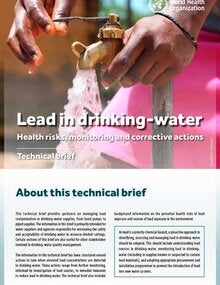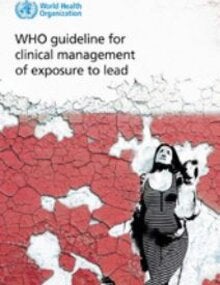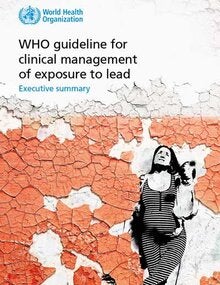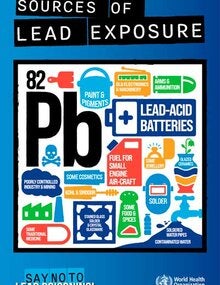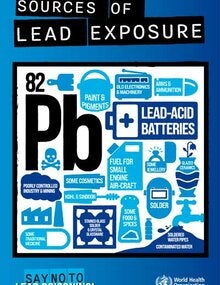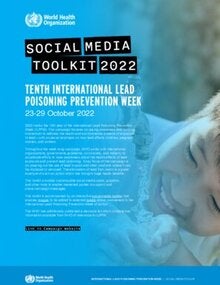El plomo es un metal tóxico cuyo uso generalizado ha causado contaminación ambiental y problemas de salud en muchas partes del mundo. Es una sustancia tóxica acumulativa que afecta a los múltiplos sistemas corporales, incluidos los sistemas cardiovasculares y neurológicos, hematológicos, del aparato digestivo, renales. Los niños son especialmente vulnerables a los efectos neurotóxicos del plomo, y aun los niveles relativamente bajos de exposición pueden causar daño neurológico grave y en algunos casos irreversible.
Recientes reducciones del uso de plomo en gasolina, la pintura, la plomería y la soldadura han resultado en reducciones sustanciales de las concentraciones de plomo en sangre a nivel de la población. Sin embargo, fuentes significativas de la exposición todavía sieguen, en particular en los países en desarrollo.
Esfuerzos adicionales son necesarios para continuar reduciendo el uso y las liberaciones del plomo y reducir las exposiciones ambientales y laborales, en particular para los niños y mujeres en edad fecunda. Las intervenciones incluyen eliminar usos no esenciales de plomo como plomo en pintura, garantizando el reciclaje seguro de desechos que contiene plomo, educando el público acerca de la importancia de eliminación segura de acumuladores de plomo y computadoras y seguimiento en el monitoreo de niveles de plomo en la sangre en niños, mujeres en edad fecunda y trabajadores.
- El plomo es una sustancia tóxica que va acumulándose en el organismo y afectando a diversos sistemas. Es especialmente nocivo para los niños de corta edad.
- El plomo se distribuye por el organismo hasta alcanzar el cerebro, el hígado, los riñones y los huesos. Se deposita en dientes y huesos, donde se va acumulando con el paso del tiempo. La exposición humana se suele evaluar midiendo la concentración de plomo en sangre.
- El plomo presente en los huesos pasa a la sangre durante el embarazo y se convierte en una fuente de exposición para el feto a lo largo de su desarrollo.
- No existe ningún nivel por debajo del cual se pueda afirmar que la exposición al plomo no tiene efectos nocivos.
- La exposición al plomo es prevenible.
Las personas pueden verse expuestas al plomo en su lugar de trabajo o en su entorno, principalmente a través de:
- la inhalación de partículas de plomo generadas por la combustión de materiales que contienen este metal (por ejemplo, durante actividades de fundición, reciclaje o decapado de pintura con plomo, o al utilizar combustible para la aviación con plomo); y
- la ingestión de polvo, agua o alimentos contaminados con plomo (por ejemplo, agua canalizada a través de tuberías de plomo o alimentos envasados en recipientes con esmalte de plomo o soldados con este metal).
Los niños pequeños son particularmente vulnerables a la intoxicación por plomo porque, según la fuente de contaminación de que se trate, llegan a absorber una cantidad de plomo entre cuatro y cinco veces mayor que los adultos. Asimismo, su curiosidad innata y la costumbre, propia de su edad, de llevarse cosas a la boca los hacen más propensos a chupar y tragar objetos que contienen plomo o que están recubiertos de este metal (por ejemplo, tierra o polvo contaminados o escamas de pintura con plomo). Esta vía de exposición es aún mayor en los niños con un trastorno psicológico denominado pica (ansia persistente y compulsiva de ingerir sustancias no comestibles), quienes pueden arrancar y tragar escamas de pintura con plomo de las paredes, los marcos de las puertas o los muebles. En Nigeria, el Senegal y otros países, la exposición a tierra y polvo contaminados por plomo debido al reciclaje de baterías y a actividades mineras ha provocado intoxicaciones masivas por plomo y numerosas muertes en niños pequeños.
Una vez dentro del cuerpo, el plomo se distribuye hasta alcanzar órganos como el cerebro, el hígado, los riñones y los huesos. Se deposita en dientes y huesos, donde se va acumulando con el paso del tiempo. El plomo almacenado en los huesos puede volver a circular por la sangre durante el embarazo, con el consiguiente riesgo para el feto. Los niños con desnutrición son más vulnerables al plomo porque sus organismos absorben mayores cantidades de este metal en caso de carencia de otros nutrientes, como el calcio o el hierro. Los niños que corren un mayor riesgo son los de muy corta edad (incluidos los fetos en gestación) y los que viven en medios económicamente desfavorecidos.
Lead is a toxic metal whose widespread use has caused extensive environmental contamination and health problems in many parts of the world. It is a cumulative toxicant that affects multiple body systems, including the neurologic, hematologic, gastrointestinal, cardiovascular, and renal systems. Children are particularly vulnerable to the neurotoxic effects of lead, and even relatively low levels of exposure can cause serious and in some cases irreversible neurological damage.
Recent reductions in the use of lead in petrol, paint, plumbing and solder have resulted in a substantial reduction in population-level mean blood lead concentrations. However, significant sources of exposure still remain, particularly in developing countries.
Further efforts are required to continue to reduce the use and releases of lead and to reduce environmental and occupational exposures, particularly for children and women of child-bearing age. Interventions include eliminating non-essential uses of lead such as lead in paint, ensuring the safe recycling of lead-containing waste, educating the public about the importance of safe disposal of lead-acid batteries and computers, and monitoring of blood lead levels in children, women of child-bearing age and workers.







